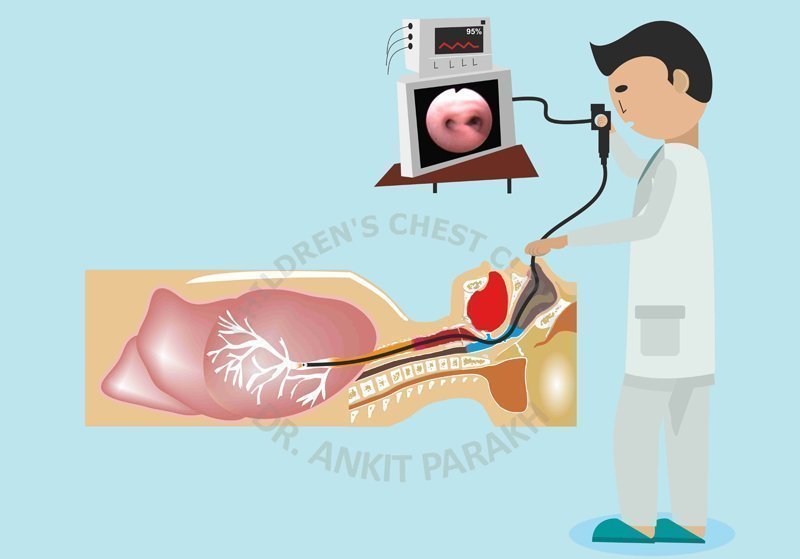
Flexible Bronchoscopy in Children
Flexible Bronchoscopy is a very important procedure for diagnosing and managing various respiratory conditions in children. This minimally invasive technique allows detailed visualization of the airways, aiding in accurate diagnosis and targeted interventions.
What is Flexible Bronchoscopy?
Flexible bronchoscopy is a procedure that involves using a thin, flexible tube equipped with a light and camera (bronchoscope) to examine the airways. This technique provides real-time images of the trachea, bronchi, and smaller air passages. In children, it is particularly useful for identifying structural abnormalities, foreign bodies, infections, and other respiratory issues.
How is Flexible Bronchoscopy Performed in Children?
- Preparation: The child’s medical history is reviewed, and fasting is typically required for a few hours before the procedure. Sedation is administered to ensure comfort.
- Procedure: The bronchoscope is gently inserted through the nose and guided into the airways. During the procedure, images are displayed on a monitor, allowing the pulmonologist to assess the condition of the airways.
- Intervention: If needed, therapeutic procedures like suctioning mucus, removing foreign bodies, or obtaining tissue samples (biopsy) can be performed.
- Post-Procedure Care: After the procedure, the child is monitored until the effects of sedation or anesthesia wear off. Mild throat discomfort may occur but usually resolves quickly.
Why is Flexible Bronchoscopy Important in Pediatric Care?
- Comprehensive Diagnosis: It enables direct visualization of the airways, providing invaluable information for accurate diagnosis.
- Therapeutic Applications: Beyond diagnosis, bronchoscopy can help remove obstructions, clear secretions, and deliver medications directly to the lungs.
- Minimally Invasive: It offers a safe and effective alternative to more invasive surgical procedures.
- Guided Decision-Making: The findings from bronchoscopy guide treatment plans, ensuring personalized care for each child.
Common Conditions Diagnosed or Treated with Flexible Bronchoscopy
- Chronic cough or recurrent wheezing
- Foreign body aspiration
- Persistent pneumonia or atelectasis
- Suspected tuberculosis (TB)
- Noisy breathing/stridor
- Congenital airway abnormalities (e.g., tracheomalacia, bronchomalacia)
- Suspected tumors or growths
Flexible bronchoscopy is a cornerstone in pediatric respiratory care, offering unparalleled insights and therapeutic benefits. If your child is experiencing persistent respiratory issues or requires further evaluation, consider consulting with a pediatric pulmonogist. For any bronchoscopy related query you can get in touch with Dr Ankit Parakh.
Conclusion
Pediatric flexible bronchoscopy services at BLK MAX Hospital
The division of pediatric pulmonology BLK MAX hospital has a busy bronchoscopy service dedicated to children and newborn babies. State of the art equipment is available from Olympus Medical with video bronchoscopes ranging from various sizes for newborns to older children and adolescents. We have also been performing advanced bronchoscopy interventions in children like removal of foreign bodies, transbronchial lung biopsy, lung cryobiopsy, endobronchial ultrasound guided transbronchial needle aspiration (EBUS-TBNA), air balloon dilatation and placement of stents in the pediatric airway. The unit also has facility for performing rigid bronchoscopes in children. Bronchoscopy services are available 24 X 7 in the hospital.
Related Video
Frequently Asked Questions (FAQs)
1. Is flexible bronchoscopy safe for children?
Yes, it is a safe procedure when performed by experienced pediatric pulmonologists. The use of sedation and anesthesia ensures the child’s comfort and minimizes risks.
2. How long does the procedure take?
The procedure itself usually takes 10-15 minutes, but the total time, including preparation and recovery, may range from 1 to 2 hours.
3. What are the potential risks?
Complications are rare but may include mild bleeding, temporary hoarseness, or low oxygen levels during the procedure. These are closely monitored and managed promptly.
4. How soon can the child resume normal activities?
Most children can return to their regular activities within a day.
5. Is flexible bronchoscopy painful?
No, the procedure is not painful as sedation or anesthesia ensures the child is comfortable throughout.



